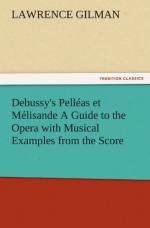Pelleas enters, and there is an impassioned declaration of his theme, scored, f, for wood-wind, horns, and strings, as he observes that he is about to depart, “crying out for joy and woe like a blind man fleeing from his burning house.” There is a return of the Melisande theme; and then, as she herself enters, and Pelleas urges her not to stay at the edge of the moonlight, but to come with him into the shadow of the linden, there enters a theme of great beauty and tenderness, announced, mysterieusement, by horns and ’cellos (page 236, measure 6). I may call it, for want of a better name, the motive of The Shadows, since it appears only in association with the thought of sheltering darkness and concealment:
XVII. THE SHADOWS
[Illustration: Modere]
We hear the Fate motive when Melisande warns Pelleas that it is late, that they must take care, as the gates of the castle will soon be closed for the night. There is a gracious variant of this motive as Melisande tells how she caught her gown on the nails of the gate as she left the castle, and so was delayed. Then comes a reminiscence of the Fountain theme (the authentic wonder of which is that it is not a theme at all, but merely a single chord introduced by a grace-note; yet the vividness of its effect is indisputable), suggested, pp, by horns and harp, at Melisande’s words: “We have been here before.” As Pelleas asks her if she knows why he has bidden her to meet him, strings and horn give out, pp et tres expressif, a lovely phrase derived from the Pelleas theme (page 242, measure 1). Their mutual
XVIII
[Illustration: Modere]
confessions of love, so simply uttered in the text, are entirely unaccompanied by the orchestra; but as Pelleas exclaims: “The ice is melted with glowing fire!” four solo ’cellos, with sustained harmonics in the violins and violas, sound, pianissimo, a ravishing series of “ninth-chords” (page 244, measure 6)—a sheer Debussy-esque effect, for the relation between the chords is as absolutely anarchistic as it is deeply beautiful. “Your voice seems to have




